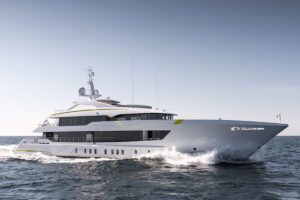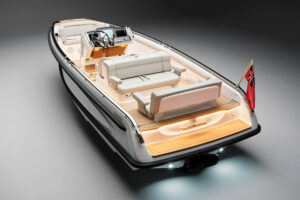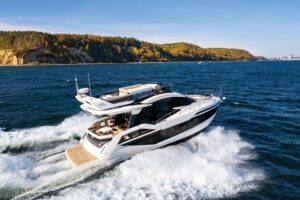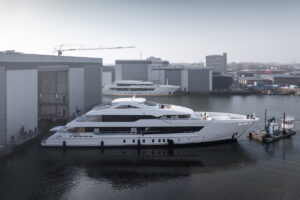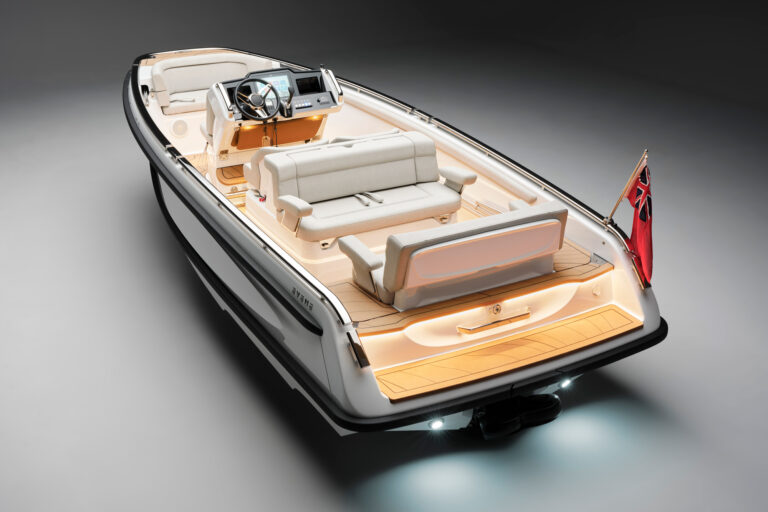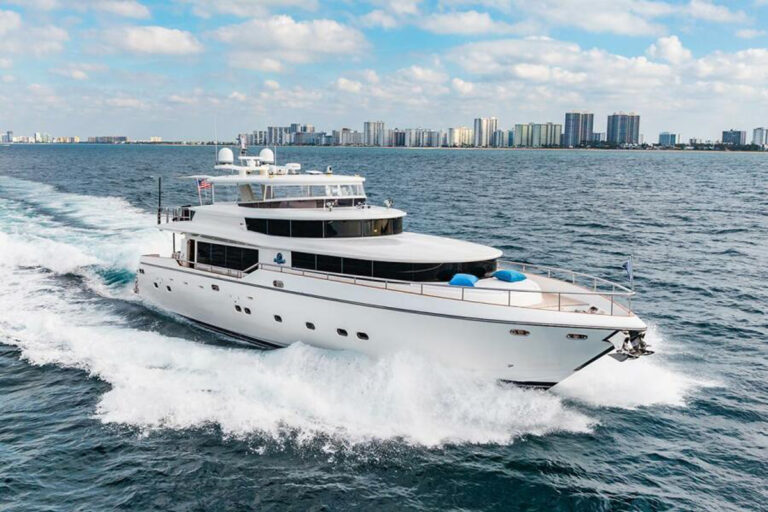I’d been looking forward to inspecting Sea Ray‘s new 500 Sedan Bridge since I caught wind of her introduction while spending time aboard her larger sister-the 550 Sedan Bridge (“Easy Rider”, June 2004). She’s closely related to the 550, and I was interested in seeing how Sea Ray‘s design team handled the challenge of shrinking the 550’s concept into a package that’s roughly six less feet LOA and a foot less in beam.
I met with Mike Fafard, director of Sea Ray‘s Sport Yacht and Yacht program at the builder’s Product Development and Engineering facility in Merritt Island, Florida. Fafard is an integral part of the team approach that Sea Ray used to develop and build the 500.
“Our design, production and sales team leaders work together from start to finish on each project”, said Fafard. “This helps insure that the project remains on target and is a good fit in the market and in our lineup.”
After spending some time on board the 500, it is apparent the process works. It took a minute for my eye to discern the subtle differences in scale between the 500 and the 550. She features the signature design cues that are common with the Sedan Bridge line, as well as a few new twists.
“We try to improve each new design with the lessons we learn with the last”, said Fafard. “However, we move ahead at a measured pace so that a new Sea Ray is still identifiable as a Sea Ray.”
A sweeping reverse sheer caps her dark blue hull-a gelcoat finish option Sea Ray began offering several years ago.
Though old-school thinking calls for a white hull, response from prospective customers has been enthusiastic. The look is pleasing and at least for the time being different. Those who fancy it should remember that a chamois is a must, as dark colors typically require additional buffing up. Finished exterior surfaces and molding detail are first-rate-a result of Sea Ray’s investment in computer-cut tooling.
The 500’s swept-back deckhouse is fitted with a curved frameless glass windshield and side windows. A shapely stainless steel arch-an improvement over the 550’s coated aluminum arch-caps the bridge. The fiberglass hardtop serves as the foundation for the integral clear-vinyl enclosure. There are zip-outs, and a hardtop hatch is standard. The bridge can also be equipped with reverse-cycle air-conditioning, which creates an all-weather helm when the access hatch to the bridge is closed.
The self-draining cockpit has seating across the transom and is fitted with a transom door. Sea Ray has abandoned hydraulic transom-mounted tender lifts in favor of a fixed tender/swim platform and a davit. This is a far less complicated arrangement, and the optional low-profile davit tucks away out of sight in a transom locker. An 11-foot Boston Whaler is listed as an option. I would also opt for the cockpit ice maker and stainless steel grill. Wide side decks allow easy access to the foredeck sunning area. An anchor windlass is standard, however, those who spend a lot of time swinging on the hook should consider the all-chain option.
A molded-in staircase leads from the cockpit to the bridge. The control station has helm and companion seating and the console has room for the full-blown Raymarine electronics package that includes an autopilot, a chart plotter and radar. All are standard, as is a Sea Ray Navigator II system with a 12.1-inch display. I have used this system on a number of occasions, and if there is such a thing as foolproof navigation, this is it. A curved seating area with a table is forward of the helm. The wet bar has a sink, a trash receptacle and a refrigerator. Bench seating abaft the helm is unique to the Sedan Bridge in Sea Ray‘s line.
A sliding glass door, framed in stainless steel, leads from the cockpit to the main cabin. While the 500 has less volume than the 550, her interior arrangement is remarkably similar and seems to have suffered little compromise.
“While we can see a lot of detail on the drawing board (computer), there is no substitute for living with the real thing-the success of the 550 has helped us fine-tune the 500’s layout”, Fafard said. The main cabin seating arrangement includes a curved sofa and an optional pullout bed/sofa. The entertainment center has a 26-inch flat-screen TV. The galley is equipped with Sub-Zero refrigeration, a microwave/convection oven and a cook top. The dinette is an arm’s length away.
Although the 500 doesn’t have a full-beam master stateroom, as does her larger sister, her accommodations offer the same level of comfort and head count. The master stateroom is forward and has a queen-size island berth and a private head with a shower. There are two guest staterooms, one with a queen-size berth and one with upper and lower single berths. The guest stateroom shares a dual-access head with a shower. Berths are fitted with innerspring mattresses.
While the interior décor package follows a theme common to the line, I noticed a number of subtle differences that suggest an upgrade to the standard. Raised-panel cherry doors now complement the faux-cherry finish. Soft goods and cherry trim also appear to be applied with a more creative eye. Those who intend to cruise should opt for the combo washer/dryer in a space beneath the galley. A lower control station (nice for cold weather) and crew’s quarters will be available in January 2005.
The 500 is built with a blend of stitched and woven fiberglass reinforcements and polyester resin. Vinylester resin below the waterline helps prevent blistering. The bottom is a solid laminate supported by a network of fiberglass stringers and plywood bulkheads. Balsa coring is used to stiffen the exterior deck. While this is conventional boatbuilding fare, the environment on Sea Ray‘s production floor is worthy of note. I have toured a number of the company’s facilities over the years and have always been impressed by the focus its craftsmen have on the product. Their pride shows in the 500.
A large hatch in the cockpit sole leads to the machinery space. A 13.5 kW generator in a sound shield is in the lazarette area, and the main engines are immediately forward. Access to the engine’s inboard service points is excellent, although tankage limits access outboard. However, hatches in the saloon sole can be removed if necessary. Owners who cruise in areas where shorepower is less than perfect should opt for the isolation transformer.
The 500’s hull form follows a proven Sea Ray formula with moderate deadrise (15 degrees) at her transom. Hull number one was fitted with the standard power, a pair of 640 hp, Cummins QSM-11s. She transitioned easily to a plane at about 16 knots and reached a maximum speed of 31.2 knots (2350 rpm) in 25 seconds. I recorded a speed of 27.9 knots at 2100 rpm, and the standard SmartCraft electronics indicated a fuel burn of 50.3 gallons per hour.
The 500 has a base price of $1,012,666, or, about $313,000 less than the 550. A tough call indeed-either one is a good choice.
Contact: Sea Ray Boats, 800-SRBOATS; www.searay.com.

